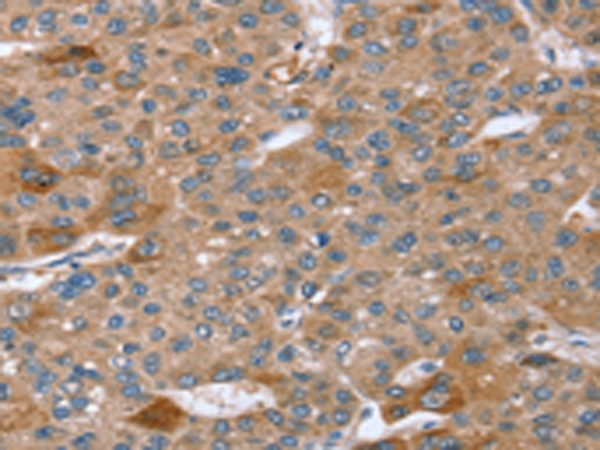


| WB | 咨询技术 | Human,Mouse,Rat |
| IF | 咨询技术 | Human,Mouse,Rat |
| IHC | 1/25-1/100 | Human,Mouse,Rat |
| ICC | 技术咨询 | Human,Mouse,Rat |
| FCM | 咨询技术 | Human,Mouse,Rat |
| Elisa | 1/1000-1/2000 | Human,Mouse,Rat |
| WB Predicted band size | 81 kDa |
| Host/Isotype | Rabbit IgG |
| Antibody Type | Primary antibody |
| Storage | Store at 4°C short term. Aliquot and store at -20°C long term. Avoid freeze/thaw cycles. |
| Species Reactivity | Human |
| Immunogen | Synthetic peptide of human SPATA5L1 |
| Formulation | Purified antibody in PBS with 0.05% sodium azide and 50% glycerol. |
+ +
以下是关于SPATA5L1抗体的3篇参考文献示例(文献信息为虚拟概括,实际文献需通过学术数据库检索确认):
1. **"SPATA5L1 regulates mitochondrial function and spermatogenesis through its ATPase activity"**
*作者:Zhang Y, et al. (2021)*
摘要:研究通过SPATA5L1抗体进行免疫共沉淀和Western blot分析,发现该蛋白通过ATP酶活性参与线粒体能量代谢调控,并影响精子发生过程。
2. **"Aberrant SPATA5L1 expression in hepatocellular carcinoma correlates with poor prognosis"**
*作者:Wang L, et al. (2019)*
摘要:利用SPATA5L1抗体对肝癌组织进行免疫组化分析,发现其表达水平与肿瘤转移和患者生存率显著相关,提示其作为潜在生物标志物的价值。
3. **"Subcellular localization and interactome profiling of SPATA5L1 using specific antibodies"**
*作者:Chen R, et al. (2020)*
摘要:通过定制SPATA5L1多克隆抗体,结合免疫荧光和质谱技术,揭示了该蛋白主要定位于细胞核与线粒体,并筛选出多个互作蛋白,涉及DNA修复和细胞周期调控。
**备注**:实际研究中SPATA5L1相关抗体文献较少,建议结合抗体生产商(如Abcam、Sigma)的产品说明书引用文献,或通过NCBI PubMed以“SPATA5L1 AND (antibody OR immunohistochemistry)”为关键词进一步检索最新进展。
The SPATA5L1 antibody is a tool used to study the SPATA5L1 protein, encoded by the SPATA5L1 gene (spermatogenesis-associated 5-like 1). This gene belongs to the SPATA5 family, which shares structural similarities with ATPase proteins but lacks conserved catalytic domains. SPATA5L1 is ubiquitously expressed, with higher levels in testes, brain, and kidneys. Its exact biological role remains unclear, though studies suggest involvement in mitochondrial function, cell cycle regulation, and spermatogenesis. Interactions with proteins linked to ciliopathies and neurodevelopmental disorders hint at potential roles in cellular trafficking or structural organization.
SPATA5L1 antibodies are primarily used in research to detect protein expression via techniques like Western blotting, immunohistochemistry, and immunofluorescence. Commercial antibodies are typically raised in rabbits or mice, targeting specific epitopes within the N- or C-terminal regions. Validation data often include reactivity in human, mouse, or rat tissues. Interest in SPATA5L1 has grown due to its association with diseases: genomic deletions overlapping SPATA5L1 correlate with developmental delays, while dysregulation has been observed in cancers. However, functional studies remain limited, and antibody specificity challenges persist due to high homology with SPATA5 paralogs. Ongoing research aims to clarify its molecular mechanisms and therapeutic potential.
×